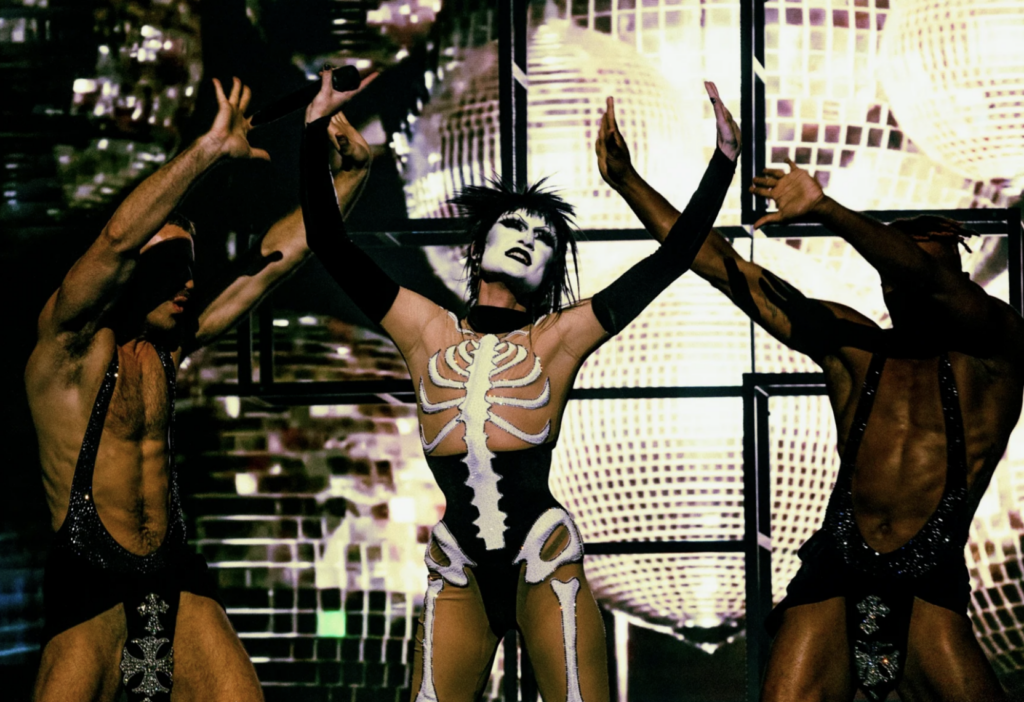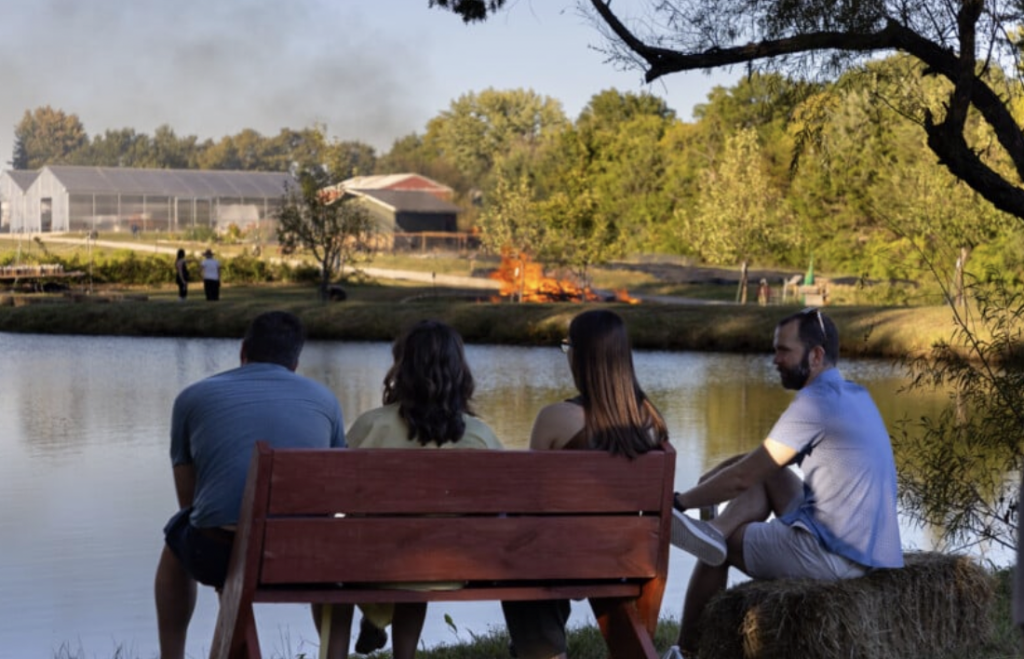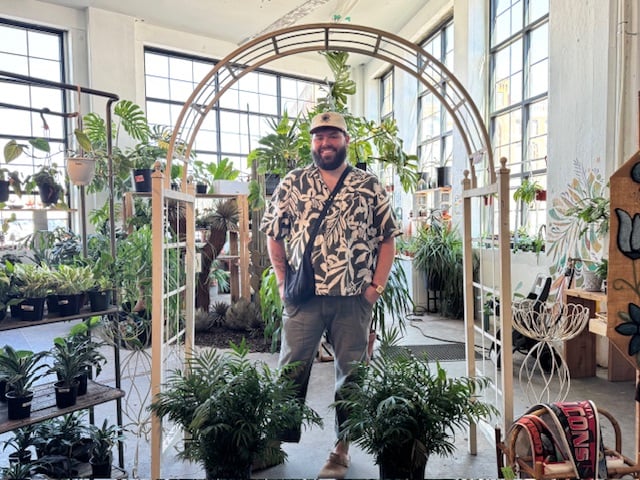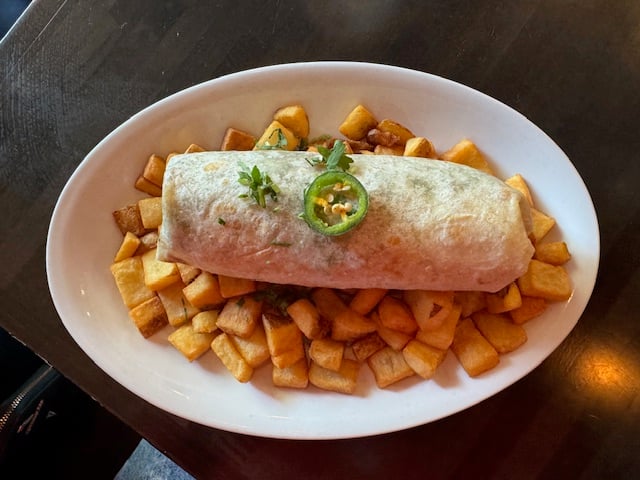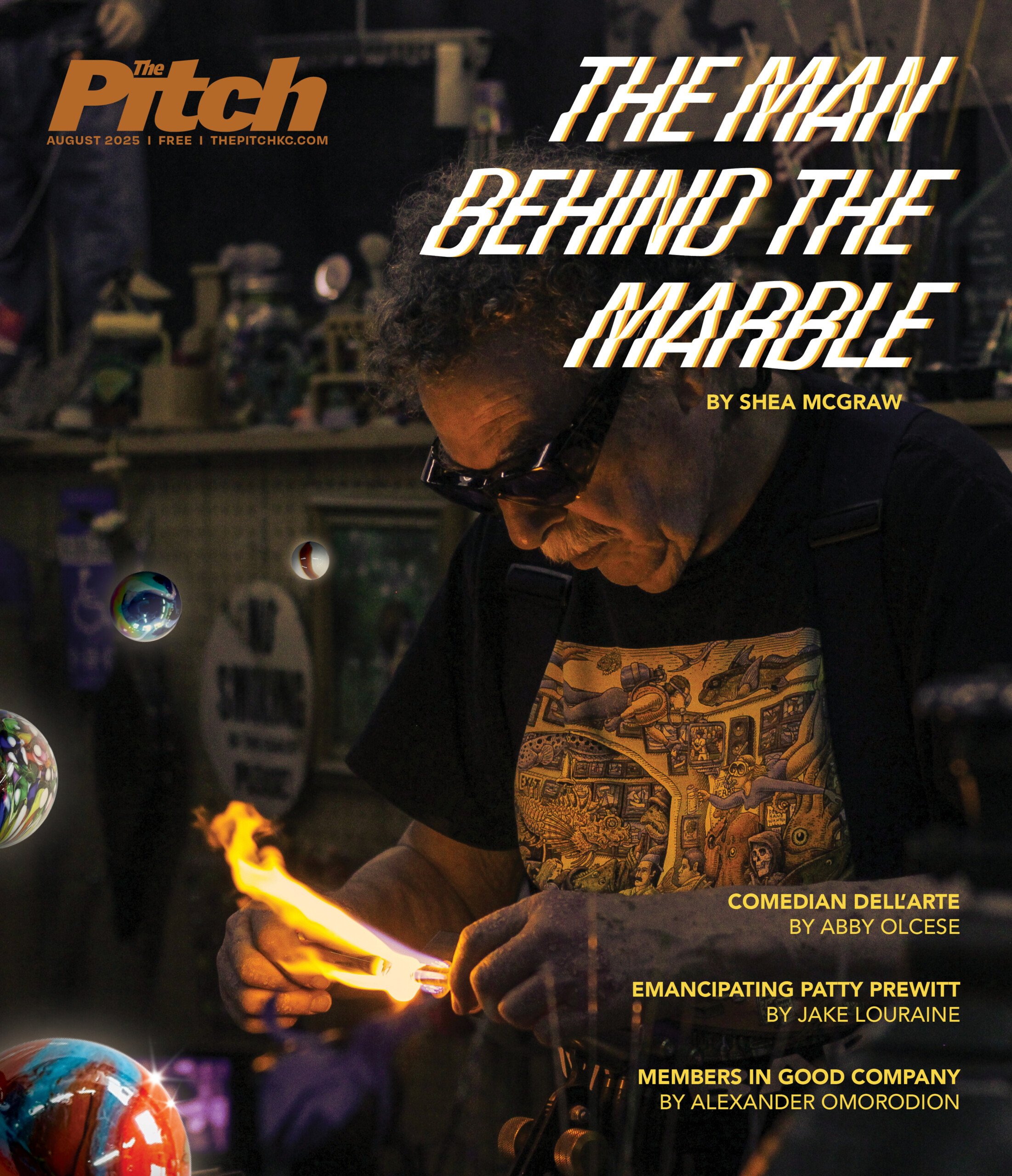T-Shirt Tombstones

Shavone Banks lays five white T-shirts that memorialize her dead friends across her lap in the front room of her apartment at 82nd Street and Troost. The TV is tuned to the Food Network. It’s 10 a.m., and 21-year-old Banks, dressed in pink sweat pants, has been eating a bowl of cereal. She worked a long night shift at a halfway house on Truman Road.
She shows off her shirts in no particular order. The one on top of the pile says “RIP Kristi” above a school picture of a smiling high school girl. This is Kristi Carroll, shot to death in 2002 during a party at the Troostwood Banquet Hall. Carroll and Banks were schoolmates.
“I wanted to go to that party so bad. I literally cried,” Banks recalls. But she couldn’t find a ride. “It was one of those where everyone was supposed to be there. I was so mad that tears were actually shed because I didn’t get to go to that party.”
Lately, Banks has been showing up at “stop the violence” marches and vigils held around Kansas City. But though such shirts are worn at funerals and vigils, Banks doesn’t reserve her collection of memorial shirts exclusively for such occasions. “You can wear it anytime. I wear it with an outfit, just any day. I get kind of sad when I pick them up and wear them.”
She pauses. “Ready for some more?”
T-shirts for the dead might seem cavalier to some, but for kids on the city’s east side, murder is common.
Last year, 127 murders nearly set a record in Kansas City, Missouri. With another 85 slayings this year, memorial shirts remain in high demand. Inner-city kids tell each other, “Don’t let me see you on a T-shirt.” Last year at Fairview Alternative Middle School, the glass case outside the office held the memorial T-shirt of a 14-year-old shot on Mother’s Day 2005.
The shirts always have a picture. Often, it’s someone laughing, hanging out at a party, mixing a drink. Sometimes it’s a school photo, with its familiar gray-blue background. Sometimes the photo implies a violent end: glaring eyes, a gun, a hand sign. More often, the figure flashes only a contagious smile.
That’s the kind of photo on the next shirt in Banks’ collection, which reads “In Loving Memory” and depicts a guy named Deondre Thomas. It was made at the Landing Mall.
“Ron — he was my boyfriend at the time,” Banks says. To check the date, she pulls out a photo album thick with funeral programs. He died on September 20, 2003. “‘Course, he was killed on 40th, near Warwick. I’d been liking him since I’d seen him in the neighborhood, and we’d just started dating. We were sneaking because my mom didn’t want me to be dating.”
Click play above for a slideshow of photos.
When a friend called her to tell her that Ron was dead, she threw down the phone and ran outside screaming. “He had just been at my house that night. We were sitting in his car out front for one hot second. I gave him a little hug and said, ‘I guess I’ll see you later.'” She shrugs. She thinks they caught his killer, but she isn’t sure. “Yep,” she says, popping the p at the end of the word.
She pulls out the next shirt, for a guy who was killed on February 20, 2005. In the picture, the man stares out the window of a white car. A tree-shaped air freshener hangs from the rearview mirror. “This is Jason Smith. They call him Brother J. He was killed at 55th and Park in a home invasion.” The details pour out matter-of-factly. “The people, I guess they wanted money, so they went either to his mom’s house first and pistol-whupped her, or else they went to his house first and kicked in the door. The police said they killed him in front of his children. They shot his kids’ mother, also, but she didn’t die. I think she’s blind in one eye. The bullet came out her eye or something.”
[page]
Police flooded the funeral, Banks remembers, to prevent retaliation. “You would think it was a presidential funeral, the way the police were there with their guns out and drawn, waiting for someone to do something wrong, and helicopters flying over us.” She runs her fingers over a series of letters running down the side of the picture: SYATCR. “I don’t know what that means,” she says.
Suddenly, the buzzer to her apartment rings, and she invites in Kyeshu Harris, her cousin by marriage. “Just in time,” Banks says as they settle down on the couch next to each other. Harris wears a green tank top and blue cotton pants. She got someone to watch her baby so she could come to Banks’ place and discuss shirts.
Banks hands her a shirt. “He got shot in the stomach at 39th and Campbell,” Harris says simply, holding up the shirt of her cousin, Neal Lovings, who died on May 1, 2006. In the picture, Lovings stands in front of a house, posing for the camera in a Francois Girbaud designer T-shirt.
Harris says the killing is unsolved. “We didn’t know he had enemies,” she says. “Like, who could have did this that we know of? We heard that he was offered a ride and he got in a car, and the person shot him and threw him out.”
Banks picks up the last shirt in her lap, the one she was saving for last. It’s faded. “This is my cousin, Willis. He got killed May 23, 2003.” His murder, too, remains unsolved. Willis “DaReelis” Johnson was a rapper, a private person who never answered the door for anyone he didn’t know. His death was painful for Banks because he was the cousin who always talked about the importance of going to college and gave her advice on choosing her boyfriends wisely. Banks heard snippets of the scenario from family rumors and the police. “A girl knocked on his door, and he opened it, and some men she was with gunned him down,” Banks says. “They just shot him up.”
For a moment, the room stays silent.
“I seen more death than anyone I know,” Harris says suddenly. She says six or seven names. Banks points out that one was killed in a car crash. Harris says it still counts.
“It was a high-speed chase that cut the car in half,” she says. “One of his arms was in one half, one of them was in the other.”
Banks asks Harris what SYATCR stands for.
“Oh,” Harris says. “It means ‘See you at the crossroads.'”
Chris evans flips through a stack of unclaimed photos in his office at T-Shirt King, next door to Gates Barbecue at 12th Street and Brooklyn. These are the photos of dead loved ones that family and friends bring to Evans so that he can put them on T-shirts. Sometimes they forget to get the original pictures back.
[page]
“I think she had a heart attack,” he says, pointing to a picture of a woman sitting on a couch. “I think he was killed in a home invasion.” He points to a young guy in a Washington Bullets jersey who smiles in a professional studio shot. Evans flips past a sepia-toned picture of a man in a banded hat and past a picture of a baby.
Evans operates this store, which his father, Carl Evans, opened in 1985. Carl Evans was an inner-city principal before he retired, and the bulk of the business has been uniforms for school teams and T-shirts for fund-raisers. But in the past five years, demand for personalized memorial tees has risen enough that the store prints 10 to 15 shirts in an average week — more if the deceased was particularly popular. Evans, 30, scans his customers’ photos into a computer. He can also add words. “Then they’ll pretty much decorate the shirt, the sleeves, the collars, the back, the front, the sides. Everywhere imaginable.”
The store is plastered with photographs of the dead. There’s a photo of a dozen young men posing after a funeral in shirts with bold letters that spell “Big Business,” a photo of the friend they were memorializing that day visible in the shot. There are pictures of a miracle baby — an infant who was shot but survived. There’s one of a young girl, accidentally killed with the swing of a golf club.
“I don’t think it’s as emotional as working in a funeral home, but it’s a way to kind of ease pain, too,” Evans says.
The nightly news helps him predict his workload. “I watch TV as much as anybody else, so we see all the homicides and know who to expect to see coming in,” he says.
Evans thinks that the deaths of hip-hop stars Tupac Shakur and Biggie Smalls — both of whom predicted their own murders in their raps — inspired the trend to memorialize people in cotton. One customer even took rapper-style martyrdom to the next level, requesting his own memorial T-shirt. “He was like, ‘I know it’s me, but do it anyway.’ Which was kind of odd,” Evans says. He shrugs.
Not much shocks Evans anymore. Multiple girls will come in with the same photo, wanting T-shirts of the same guy, each calling him her boyfriend. One woman brought in a picture of a man with another woman and asked if Evans could cut out the other woman’s face and replace it with her own. Evans refuses some orders: shirts with crosshairs printed over someone’s face, shirts with threatening phrases, “Stop Snitching” shirts. He says he doesn’t want to make money that way.
Not all of the commemorative T-shirts that Evans makes are for the innocent. At his computer, Evans pulls up a cluster of images from a project he recently finished. The shirts memorialize 17-year-old Terrion “T-Nutty” Carter and 22-year-old Darren “Neph” Norton. On March 28, they were attempting to break into a house at 5709 Newton when the owner shot and killed both of them.
The shirts that Evans made for the deceased boys are covered with the codes of their neighborhood: “RIP, Eddie Street to the Black Top, Nigga it don’t stop, 3 times crazy.” Evans says the phrases mean something to the gang members who claim 33rd Street and Bales. One shirt reads “The Click Clack Gang — Free Duck!”
“Sometimes I ask questions. Sometimes I don’t,” Evans says. Often, he gets a sense of what happened just by overhearing his customers’ conversations.
[page]
Some of Evans’ patrons aren’t as emotional as might be expected. “Because the younger generation has learned to deal with death a lot different than the older generation has,” Evans explains.
He points to a shirt that hangs above the doorway of the shop. On it is a picture of a baby-faced man, with gold and diamond caps across his front teeth, and the words “Chuby Throwback.”
“He’s like a local Tupac,” Evans says. Chuby Throwback died three years ago, but Evans says he still gets regular requests to print the shirt. “He has tons of followers.”
Myron Evans — aka Chuby Throwback — died on May 20, 2003. He was found in the road, in the 4900 block of Olive, near the burning remains of his GMC Yukon.
Minutes before his death, Evans had taken a stack of cash from 27-year-old Clinton Wilson. Chuby was supposed to give Wilson $11,000 worth of cocaine. Instead, Evans just smiled. Wilson shot him.
Evans got out and ran, but he didn’t get far before Wilson shot him again. Evans collapsed. Then Wilson set fire to the Yukon — a symbolic act. With 20-inch Spreewells, a purple-leather interior and paint that seemed to change colors from different angles, Evans’ Yukon was his prized possession. Wilson pleaded guilty to second-degree murder. He is now serving 22 years in prison.
Evans was a drug dealer, sure. But he was also a sort of Robin Hood on the block, seen as a hero.
One of Evans’ neighborhood friends, a 23-year-old rapper who gives his name as RonDoe, recalls Chuby Throwback’s generosity. “If moms was short on a bill and I couldn’t help all the way, ‘Hey, Chub, man, can I get $75?’ Whatever we were short. OK, boom,” RonDoe says. “Say, the Fourth of July. Nobody on the block gotta buy their kids fireworks. He gonna buy so many for his kids, and it’s too much. He’d be like, ‘Don’t even buy none, y’all can pop these.'”
Evans had a house near 57th Street and Garfield where younger kids hung out and freestyled raps. Evans converted his basement into a recording studio, with a computer and a keyboard. A friend named Diko, who had taken piano lessons, tried his hand at making beats. They recorded CDs and released them on the label Chuby Throwback Records.
“We only had it up and running for five months or so before it happened. Or whatever,” RonDoe says, momentarily dancing around any words regarding Evans’ death. “So then my other friend, Slick, he came in and started helping us out. He was like, ‘This is what Chub wanted, so go ahead and put the CD out.’ So he put the first two CDs out.”
Evans’ friend Solo, whose real name is Chris Falkner, is a tall, 25-year-old rapper with cornrows. He wears a sparkle-encrusted spinning wheel around his neck on a long gold braid. He says the “Throwback” in Evans’ nickname came from the vintage jerseys he wore. He was called “Chuby” in reference to his chubby cheeks and, later, because of his chubby pockets. “We went to Harold Pener’s,” Solo says. “Jerseys were maybe $300, $400 apiece. The dude at the desk was like, ‘Which one you want?'”
Evans bought them all.
In gratitude for kicking off their music careers, Evans’ friends repped him, dedicating rap lyrics to him. (When you change five colors and you ’bout your scratch — what’s my nigger’s name? Chuby Throwback. When you go to Harold Pener and cop the whole rack … ) They got tattoos: RonDoe sports a bubble-lettered tattoo down each forearm reading “Chubby Throwback.” (He prefers a correctly spelled version.) The way RonDoe tells it, he and his crew wore Chuby Throwback T-shirts to every concert, house party or night out in Westport for a year and a half after Evans’ death. People who didn’t know Evans in life were wearing his face on jeans, shirts and hats. They kept the T-Shirt King busy.
[page]
“There were so many of us, there was always somebody down there going to get a shirt,” RonDoe says. “They don’t even need a picture. It’s on the computer. They say they won’t ever erase it.”
Solo says people stop him on the street when he wears his Chuby shirts. “‘You know Chub? Who was Chub to you? That was my brother, my homie,'” Solo says. “He was a father to some of these guys, truthfully.”
Solo slings around a lot of euphemisms for how Evans’ pockets got chubby. He was on his business. He was a boss. But he’ll grudgingly admit that Evans sold drugs. “Yeah, he did his thing. He was hustling. Yeah. But shit, nowadays, who ain’t? For real. I ain’t gonna blame it on that. Some people, that’s all they know. And once that money start coming in, you making three, four grand a week.”
Evans was not the first friend Solo and RonDoe memorialized on a T-shirt. “I done lost a lot of homies,” Solo says. “A lot. That’s a part of life. Yeah, the dirty part about it is, it’s oh so real. It’s oh so real.”
He admits he has to watch his back. “Half these cats broke and mad, out here broke and mad with no kind of hustle. Once you start getting money and all that, they hate you…. Makes me a lot more cautious, though, a lot more cautious.”
Solo and RonDoe are working on an offshoot of Chuby Throwback Records, Keepin’ It Chuby Entertainment. RonDoe just released a solo album called Ridin’ Shotgun, and Solo is waiting a couple of months before issuing his own disc.
“Nobody ever expected it, man,” Solo says of his friend’s killing. “Because, like they say, there will never be another Tupac, there will never be another Biggie Smalls, and there will never be another Chuby. Quote that.”
Debra Green wasn’t yet 17 when she had the first of her four kids. “I was a baby having babies,” she says. She’d read statistics that children of young mothers were more at risk economically, medically and legally. So she was overprotective when it came to her two boys and two girls. When her younger son, Howard, was jumped for his Starter jacket in elementary school, she put her foot down. No more “in” clothes. Instead, her younger daughter, Winter, suffered teasing because her clothes weren’t name-brand.
When all her children got past their teens, Green stopped worrying so much. But on January 20, 2005, 26-year-old Howard Green III became the city’s ninth homicide victim of that year.
Howard Green was driving his mother’s van on Linwood near Mersington, on the way to a gas station to get a flat tire fixed. That’s when someone in another vehicle started shooting. The killer chased him six blocks while firing into the van. Howard hit a parked car near Kensington, where he died of at least one gunshot wound.
Green wears a T-shirt with Howard’s face on it. It matches a picture she had printed on a dog tag that she wears every day around her neck. Sometimes she questions the looks she gets when she wears the two together. “For us, it was a thing of showing how much we loved a loved one,” she explains.
[page]
Green lives at 34th Street and Norton, and on cloudy days, the house is dark and gloomy inside. Next door, her neighbor’s Halloween decorations blow in the wind, and plastic bones stick up out of the ground.
“One young man came up to me at the funeral and said, ‘He’s a soldier now.’ A soldier? He’s dead. A soldier for what cause? And I still don’t know. I hit the streets after it happened, asking if anyone knew anything, and one young man told me, ‘Well, that was an accident.’ Everything I hear, I tell the police, but it leads to nowhere.”
Not knowing the motive or who did it has eaten away at Green. Relatives tell her that she has grieved too long. She lost her job because Howard was the one who drove her to work in Raytown in the winter, when she was afraid of the icy roads.
“When you kill somebody,” she says, “whether you feel you’re justified or not, you’ve destroyed a family. They still function, they still breathe, but you destroyed them from what they were. They’ll never be able to go back to what they were before, because there’s an element missing.”
The slightest disagreement Howard had with someone rises to the front of Green’s mind as a possible motive. There was the time when Howard, who lived with Green, sold his ’87 Chevy Caprice to an acquaintance, who made only a down payment and then refused to pay the rest. Howard finally retrieved the car months later, only to have it stolen again the next night. Not long after that, Green’s Rottweiler disappeared and her Doberman mix turned up dead, choked to death on its chain in the backyard.
When she wears the shirt that memorializes Howard, she watches the reactions on people’s faces. Once, as she sat in the waiting room at the Swope Parkway Health Center, she caught a man staring at her. “And I can’t help but think, Were you involved in my son’s death?” she says.
But the thing that really sets her back to crying these days is thinking of her grandkids. She’s raising her son Marvell’s two boys, 15-year-old Blake and 13-year-old Marvell Jr., who’s called Papa.
Last year was a hard year for Blake. First, his uncle Howard was killed. One month later, Blake’s cousin, 15-year-old Chuck Simpson, was shot to death near East 59th Street and Indiana after stepping off a bus. Then, on May 8, 2005, Blake’s best friend, 14-year-old Cortez White, was killed after a dispute involving a lawnmower. On June 15, Blake was at the library with 12-year-old Dominique Henderson before Henderson was killed later that day by a stray bullet from a 12-gauge shotgun while standing in his backyard. And on July 14, Blake’s 16-year-old cousin, Sharrae Bowden, was stabbed to death, leaving behind a 1-year-old son.
Blake could wear a memorial shirt almost every day of the week.
During this chaos, Green says police arrested Blake, and he was charged with shoplifting a piece of chicken from a grocery-store deli. He had to go to court. His grandmother says she asked the judge if he could get her grandson some help.
[page]
“You would talk to him, and he would get in a rage, almost … I could see the anger building up in him,” Green says. “He came to me, and he said, ‘You’re just gonna let people get away with killing my uncle?’ And I said, ‘What do you want me to do?’ ‘Do something,’ he said.”
Blake started a court-ordered program in which he had to talk with a therapist. He was almost finished with the program and was making progress. Then, the night before a prayer vigil for the one-year anniversary of Howard’s death, Blake’s older brother, Steven, was shot. He lived but spent months recovering.
“When that happened, everything unraveled,” Green says. Because Blake didn’t finish his court-ordered program, the court issued a warrant for his arrest. Meanwhile, a car he was riding in was stopped by police, and when the police found a gun in the car, he claimed it.
“When they took him down to juvenile, I went to talk with him and asked, ‘Why did you have a gun?'” Green says. Blake couldn’t tell her. So she talked with his counselor.
“‘He’s scared,'” Green says the counselor told her. “‘He’s just actually scared. You can tell he’s not a bad kid, but so much is on his plate.'”
Because Blake had previously been enrolled in a court-ordered program, he was ordered to live for six months in a boys’ home in exchange for prosecutors dropping the gun charge. Green says he should be out in February.
Green wonders if her troubles can be attributed to her neighborhood, where the families of killers and victims live side by side. After Blake’s cousin Sharrae was stabbed to death, the family of the man charged with her murder moved around the corner from Green. Now, even 13-year-old Papa has been handcuffed; police responded to a call from the house after Papa threw a rock and hit a girl who is friends with the family of the alleged killer. Papa said he was trying to defend the goldfish pond that his grandmother installed in the backyard in memory of Howard; neighborhood kids had been stealing the fish. “The police came,” Green says, “and he [the girl’s father] wanted to press charges against Papa.”
She doesn’t want to see another family in matching memorial T-shirts.
“Now it’s my grandsons I got to watch out for, to try and guide them,” she says. “Because we’ve been a victim. And I see the anger they carry because of that. Now we got to try not to be a perpetrator.”
